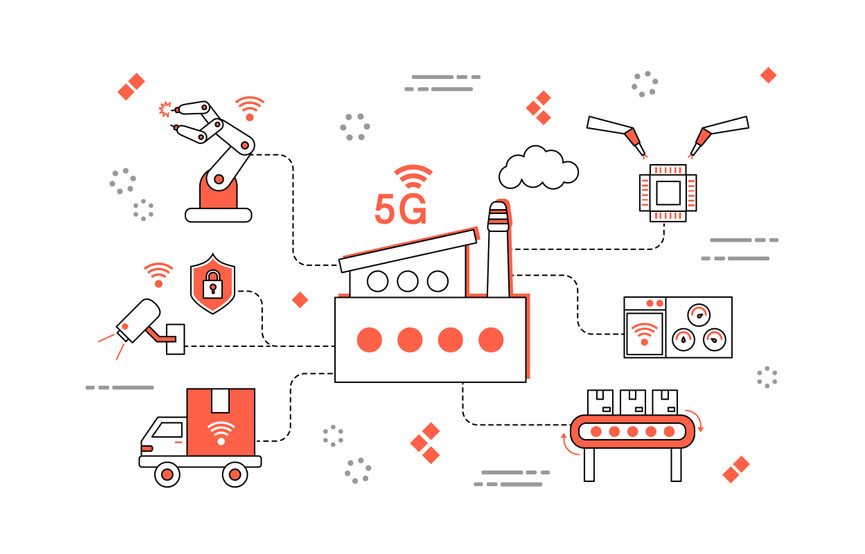Numerous use cases require 5G positioning
The roll out of 5G networks beckons a new era for telecommunications in terms of connectivity delivering low latency speeds and supporting high bandwidth applications in the enterprise. Moreover, 5G positioning provides new capability to collect and transmit location-based data from robots, equipment or people as they move around. These network attributes will enable 5G to support numerous use cases in vertical markets such as manufacturing, warehousing, healthcare and transportation.
Manufacturing plants and warehousing facilities, for example, often deploy AGVs and mobile robots to transport items with positioning techniques utilized to avoid colliding with one another or endangering staff. The benefit for 5G to provide both high quality connectivity and positioning is most welcomed by enterprises as their investment on digital infrastructure will be highly efficient.
A campus network with 5G positioning can provide high accuracy levels covering both indoor and outdoor environments, for example:
- Manufacturers need to ensure that only qualified staffs are operating machinery. This requires one meter of positioning accuracy in the plant. By scanning workers’ tags, manufacturers have confidence this is the case.
- Like manufacturing environments, chemical plants are large and hazardous. Positioning techniques need to keep track of staff within 3-5 meters which is vital in the event of an emergency.
- Hospital staff move lots of different pieces of equipment to patients’ bedside. With the help of positioning, staff know where the equipment is to the nearest meter. This both improves point of care and allows hospitals to save money because they don’t need to purchase duplicate equipment.
- Airports are another environment where critical pieces of equipment (airstairs, trailers, carts etc) are strewn over a large area. If equipment is missing, it can cause costly delays for airlines and passengers. Airports need positioning techniques to keep track of these items across the airfield within 3-5 meters.
Best practice of 5G positioning at Midea’s factory
Midea’s factory in Shunde, China, produces kitchen hoods, stoves, sterilizing cabinets and dishwashers. The plant has a production capacity of 18 million units per year.
The Shunde site comprises three major campuses and each one has invested in a private 5G campus network together with China Unicom to underpin industrial Internet and smart manufacturing technologies. Covering both indoors and outdoors, the network includes 16 macro base stations and 253 indoor small cells. The network delivers a concurrent throughput of over 600 Mbps, supporting the logistics and warehousing processes with a reliability of above 99.99%.
Facing several challenges of low efficiency in warehouse logistics, Midea identified that the network’s positioning capability needs improving so it worked with China Unicom to upgrade existing 5G networks to support positioning function as per 3GPP release 16 specifications, which saved extra huge investment and time for Midea to avoid building additional network only for positioning, such as Bluetooth or UWB.
The 5G indoor small cells deployed in warehouse measure and analyze radio signals emitted by 5G forklifts. The data collected is fed to advanced algorithms, such as UTDoA, which are deployed via Multi-access Edge Computing (MEC) to provide estimated locations of the 5G forklifts. Relying on the end-to-end smart warehouse logistic system powered by 5G positioning, drivers on forklifts and trailers in the warehouse can have an Uber-like working experience.
In the company’s warehouses, the 5G positioning reduced the average time it took to locate goods by 80%, while loading efficiency and labor working efficiency are increased by 55% and 21%. As 5G positioning continues to improve, the network will be used to keep track of more logistics trucks and workers in both indoor and outdoor environment.
Going forward with LPHAP to inspire wider applications
5G positioning will be phased as capabilities improve and so will take several years to reach its potential. “Low Power High Accuracy Positioning” (LPHAP) can support more advanced use cases as the 3GPP capabilities evolve. Currently with release 16 battery life is one day, with a second’s latency and 80% accuracy to three meters indoor. It is planned that release 18 will deliver accuracy of 90% to 0.2m, a latency of less than 0.1 second and battery life lasting a year.
3GPP release 15 and 16 supports data transmission from robots and cameras but in the coming years releases 17 and 18 will enable product designers to embed chips in safety helmets, bracelets and cards, with a battery life of more than a year. These form factors of terminals powered by 5G positioning can boost a wide range of smart applications, such as locating materials, assets and workers in various verticals.
5G positioning requires chipset and module vendors, network operators, telecoms providers, equipment manufacturers and industrial specialists to come together in a 5G ecosystem to make sure 5G devices are designed and produced in line with current and future 3GPP capabilities and specifications.
One such ecosystem was established by MLINK, to create 5G low-power and high-accuracy positioning chips, modules and terminals. The company’s MK8510 chip provides ultra-low power consumption and accurate positioning throughout 5G outdoor macro and indoor small cell network. Other participants include Fibocom, Lierda, Shenzhen Jingjiu Technology, Tsingoal, Hangzhou ccRFID MicroElectronics Co., Ltd., Hangzhou MiniFirefly, I Love Yida and Huayuen.
The example of Midea endorses that 5G positioning capabilities can contribute to a manufacturer’s efforts to improve productivity with digital technologies.
Patience will be required because Release 16 cannot support mission critical use cases. However, Release 16 provides a good opportunity to start experimenting with how 5G positioning can work for devices and vehicles location rather than critical use cases. Industry practitioners should take the opportunity to trial and familiarize themselves with the potential of 5G positioning and then with the extra accuracy, scalability and reliability afforded by releases 17 and 18, bring 5G positioning to the forefront in their facilities.

